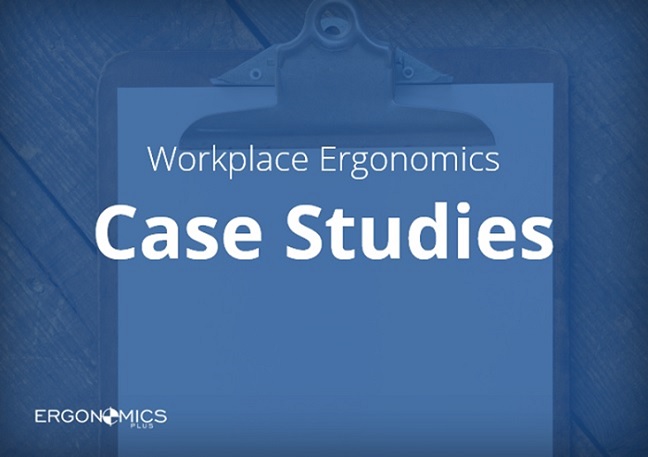In theory and practice, ergonomics is a valuable business tool. Good ergonomics reduces injury risk, improves work performance and efficiently builds a better end product.
Our monthly feature, Workplace Ergonomics Case Studies, moves away from abstract theory and dives into the real world practice of ergonomics. It’s about real people doing real work in ergonomics, with tangible takeaways and principles you can apply in your workplace right now.
This installment of Workplace Ergonomics Case Studies is submitted by Ergonomics Plus injury prevention specialist Mark Middlesworth.
Mark Middlesworth MS, ATC/L, CEES
Mark is a 1982 Purdue University athletic training graduate, and received his Master’s Degree in 1983 from Syracuse University. Mark is an NATA Certified Athletic Trainer and a Certified Ergonomics Evaluation Specialist. He has been directing workplace injury prevention services since 1989.
Job Description
A department employee survey and subsequent ergonomic evaluation revealed a high risk “problem job” and ergonomic improvement opportunity for a press operator job (pictures below) at an automobile parts manufacturing facility:
In the employee survey, several employees identified high levels of MSD risk at this operation. Out of nine operators rating the level of exertion of this job, five rated the exertion level at nine or ten on a 0-10 scale. Injury/Illness records were reviewed for the previous three years. This review revealed that there had been nine OSHA recordable MSDs over this period. Seven of the nine were injuries to the lower back; in addition there was one shoulder and one elbow case reported.
There were 196 lost/restricted days due to these injuries, and a direct cost (medical and indemnity costs only) of $166,428 with additional dollars held in reserve for cases remaining open.
Ergonomic Risk Factors
An ergonomic assessment confirmed high levels of MSD risk for the lower back due to highly repetitive side bending, and also significant shoulder and elbow risk due to reaching requirements.
Ergonomic Controls Implemented
The Ergonomics Team used the employee survey and injury records described above to justify the costs associated with recommended engineering controls for this task. Recommendations included purchasing 10 drop-side containers to be used internally between operations, along with two hydraulic lift tables to optimize the height of the containers at the press.
This eliminated side bending of the lower back and allowed the employees to place and slide the parts, eliminating MSD risk and improving productivity at the same time.

Cost of Ergonomic Improvement
The total cost of this project was $13,500. The estimated net benefits for injury cost savings and productivity gains at just one year were calculated at nearly $60,000, easily justifying the capital cost of these improvements.
This ergonomic improvement reduced fatigue and risk of injury for team members, with greater productivity and lower costs for the company.
Ergonomic Principles and Takeaways
Reduce excessive force: Muscle effort increases in response to high force requirements, increasing associated fatigue which can lead to MSD. Using mechanical assists, counter balance systems, adjustable height lift tables and workstations, powered equipment and ergonomic tools will reduce work effort and muscle exertions.
Reduce awkward postures: Awkward postures place excessive force on joints and overload the muscles and tendons around the effected joint. Eliminate or reduce awkward postures with ergonomic modifications that seek to maintain joint range of motion to accomplish work tasks within the mid-range of motion positions for vulnerable joints.
For more on ergonomic risk factors and fundamentals, read:
- How to Recognize Ergonomic Risk Factors
- 8 Fundamental Ergonomic Fundamentals for Better Work Performance
Your Free Ergonomics and Injury Prevention Education
When you sign up for free Ergonomics Plus updates, you’ll be the first to get new case studies, articles, tips and resources. Plus, you’ll get instant access to our bonus Ebook, MSD Prevention 101, just for signing up.


